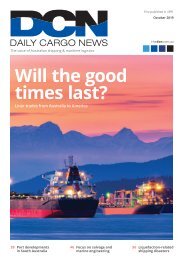DCN0718_Combined_150
You also want an ePaper? Increase the reach of your titles
YUMPU automatically turns print PDFs into web optimized ePapers that Google loves.
They explained how the Straits were a<br />
shipping bottleneck, something difficult<br />
to overcome, given its environmental<br />
sensitivity meant dredging was not<br />
an option.<br />
“Up until the last 18 months, no<br />
(larger) vessels have been able to transit<br />
through Torres Strait at draughts of greater<br />
than 12.2 metres,” Mr O’Brien said.<br />
Rio Tinto ships bauxite from Weipa<br />
down to Gladstone and every extra<br />
centimetre in draught is said to be<br />
worth an extra 80 tonnes of bauxite<br />
to the big miner.<br />
“With the right information there<br />
are opportunities to go deeper than 12.2<br />
metres,” Mr O’Brien said.<br />
“It has been quite a significant<br />
bottleneck.”<br />
The Straits are also of interest to<br />
container ships looking to sail down<br />
the east coast of Australia and to New<br />
Zealand, as well as some tanker vessels.<br />
Mr O’Brien said back in 2009 they were<br />
asked to put in a DUKC variation – the<br />
DUKC–N that was commissioned in 2011.<br />
“AMSA’s priority was safety. They were<br />
clear the system was put in to enhance<br />
safety,” he said.<br />
“But it was always recognised in the<br />
goodness of time they would look to see if<br />
they could take some of the productivity<br />
benefits from a dynamic approach.”<br />
RECENT TRIALS<br />
Mr O’Brien noted that there were four<br />
stages of testing for the new system,<br />
and each stage there were three<br />
measurements.<br />
“The first stage was three vessels with<br />
a draught of 12.3 metres (10cm deeper<br />
than had ever been allowed). For these<br />
vessels, our engineers measured the UKC<br />
and compared with what the system was<br />
saying,” he told DCN.<br />
There is environmental benefit in that there<br />
are 10 fewer ships that could ground<br />
Further tests involved Rio Tinto vessels<br />
with draughts of 12.4 metres and 12.5<br />
metres.<br />
Maximum draught trials occurred<br />
in January and February this year, one<br />
ship with a draught of 12.8 metres and<br />
another at 12.7 metres.<br />
New technology may boost maritime productivity in the Torres Strait<br />
Rio Tinto was allowed for a threemonth<br />
period to have its ships transit the<br />
Strait at 12.3 metres.<br />
This cap (for Rio Tinto) was later lifted<br />
to 12.4 metres and then 12.5 metres.<br />
An extra 30cm in draught means Rio<br />
Tinto can move close to an additional<br />
2500 tonnes extra bauxite per ship.<br />
Rio typically makes about 200<br />
shipments through the Strait every year,<br />
but extra draught means more bauxite can<br />
be loaded and thus reduce these number<br />
of shipments overall.<br />
“That is worth a lot of money and there<br />
is environmental benefit in that there are<br />
10 fewer ships that could ground,” Mr<br />
O’Brien said.<br />
A spokesman for Rio Tinto said<br />
their first priority was safety and<br />
environmental protection, so the staged<br />
implementation was carefully monitored<br />
and checked as the trials progressed.<br />
The Rio Tinto spokesman said the<br />
trials added other benefits such as<br />
improved productivity, meaning less<br />
ships and fuel required to move bauxite<br />
volumes required for the Gladstone<br />
refineries.<br />
“Rio Tinto has fully supported this<br />
project since the start, working in<br />
collaboration with AMSA and OMC,”<br />
the spokesman said. “It is great to see<br />
this project has the potential to<br />
benefit other industries too and<br />
ultimately improve in/out bound<br />
shipping costs for Australian businesses<br />
using container liners.”<br />
Shipping Australia chief executive Rod<br />
Nairn said the trials in the Strait were<br />
“a great development that has been an<br />
ongoing initiative between AMSA and the<br />
Australian Hydrographic Office for more<br />
than a decade”.<br />
“The implementation of the under-keel<br />
management system has been a great<br />
success, improving safety and protection<br />
of the environment,” Mr Nairn said.<br />
“Quite rightly the first aim was<br />
improved safety, but now that the system<br />
has been operating and has proven<br />
reliable, it is good to see that the cargo<br />
and trade benefits of the system are now<br />
being realised.<br />
“The outcome is either to reduce<br />
the number of ships required to carry<br />
a predetermined cargo or increase<br />
the cargo carried at a net benefit to<br />
the environment in terms of tonnes<br />
per kilo of CO2 produced and greater<br />
productivity. It’s a real ‘win/win’.”<br />
thedcn.com.au<br />
July 2018<br />
63

















